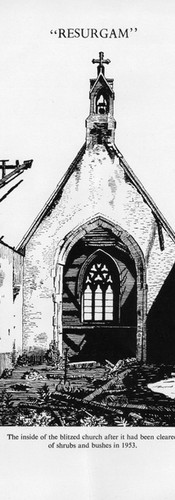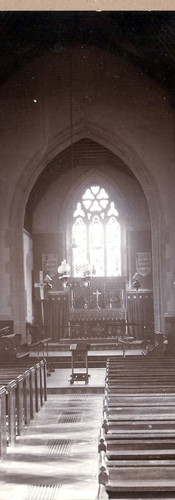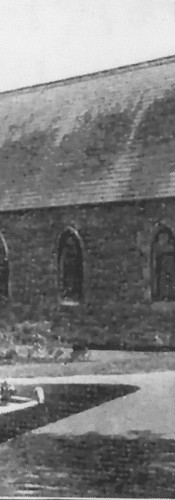A brief history of Christ Church, Pill
- Christ Church

- Sep 28, 2024
- 4 min read
Although Pill is the largest village in the Gordano Valley we should really go back many centuries to the times when Crockerne Pill, to give it its proper name, was a small hamlet within the Hundred of Portbury which, in Saxon times, was part of the earldom of Wessex (it is thought that “Hundred” was an area that was able to produce and maintain 100 armed men to defend the nation).
When King Harold was defeated by William the Conqueror the Hundred of Portbury was given to Geoffrey, Bishop of Coutances, who kept the manor of Portbury for himself but allocated Easton (which included Crockerne Pill) to a knight by the name of Roger.
Portbury had a priory and the church of St Mary the Virgin which was built in the early 12 th century (though there was evidence of an earlier Saxon church there), whilst in the 14 th century a church was built at Easton-in-Gordano, the parish being called St George’s (though, again, it is thought there may have been a wooden church or chapel before that date).
But still Crockerne Pill had none. Eventually a chapel of ease for the seafarers and inhabitants of Pill was built, but all the wedding, baptisms and funerals were held at St George’s and so that is why there were no graves around Christ Church. Church Path Road (1898) got its name from being the pathway along which coffins were carried to St George’s via Pill Field (now Newsome Avenue) and the path alongside the Red Gate Field (now at the rear of The Poplars), then through Stoneyfields to the Breeches and so on to the church.
The Formation of a New Parish
In 1861 a new ecclesiastical parish and village was formed from two hamlets – Crockerne Pill, which was formerly in the parish of St George, and Ham Green, which was formerly in the parish of Portbury (it must be remembered that the houses on the other side of Crockerne Pill (creek) at the Watchhouse were in the parish of Portbury in those days and the graves of some seamen from Pill can be found in Portbury churchyard).
On 15 October 1861 a notice was published in the London Gazette “that a Consolidated
Chapelry of Christ Church, Pill” had been formed; the population at that time was 1,860.
When the church was consecrated in 1860 it was a daughter church of St George and one of the curates, Rev C T Wilton was made priest-in-charge. Since then there have been 16 Vicars or Perpetual Curates, to give them their official title. The living, a perpetual curacy worth £50 annually, was in the gift of Rev Henry Mirehouse for his life and then lapsed to the Bishop of Bath and Wells.
The first service was at 11.30am on 27 th September 1860 and was attended by the Bishop and 18 robed clergy, being a combined service of Matins and Holy Communion, and the collection taken was £72 at a time when coal was 13 shillings (or 65p!) a ton! There was an account in the ‘Bristol Times and Mirror’ which said that after the service “a large and distinguished company partook of an elegant cold collation which was served by Pomeroy of Clifton”. That tradition is still carried on whenever there is a special
event in the church but now it takes place in the Church Rooms.
The Sunday School at that time was held in the Benevolent School next door (built in 1854 for boys, girls and infants).
Construction
The church was built of stone brought from Nailsea by Mr G Wilde whose daughter was the late Mrs Alice Oram and whose husband became a churchwarden in 1927. He held one office or another in the church until his death, but he was chiefly remembered as organist and choirmaster to hundreds of boys.
Mr and Mrs Oram’s daughter, Dorothy, was a member of the congregation until her death in September 1987.
Christ Church was a cruciform building in the decorated style consisting of chancel, nave, transept, porch and an eastern turret with one bell (in 1873 the bell ringer, Thomas Ray, was appointed and was paid £1 per annum). The roof was supported internally by wooden beams. In 1865 it cost £60 to paint and decorate the body of the church, the cost being met by Sir William Miles.
A porch and choir vestry were added in 1885 at the west end. This replaced the original porch which had been in the middle of the nave on the north side. At the same time the baptistery and West window were added in memory of William Henry Miles of Ham Green House (which became part of Ham Green Hospital) who had been Churchwarden and a generous benefactor – in 1879 Miles had provided the heating apparatus in the church, in 1880 a fine, small two-manual organ by Vowles of Bristol which was sited in the entrance of the South Transept, together with an old chest in which the music was kept, and in 1882 the pulpit.
(Note: the organ blower was paid 30 shillings a year or £1.50).
In 1885 the church, including the organ, was insured for £1,500 but by 1902 this was increased to £2,000 plus £500 for furniture.















Churchwardens
The first Churchwardens were Mrs Miles and George Wilde who were replaced at the first Vestry Meeting recorded on 13 April 1863 by W H Miles (minister’s Churchwarden) and Sidney Lloyd (Parishioners’ Churchwarden)
Support of the Church
Until 1868 the church was maintained by the Church Rate of three pence (1.5p) in the pound but in 1863 “certain ratepayers were summoned for default of paying the Church Rate” and though the Parishioners’ Churchwarden was instructed to apply to the Churchwardens of St George’s “on the subject of certain rents of Houses termed the Poor Houses and to take such steps as may be necessary in order, if possible, to obtain a proportion of the…
Windows
There were several stained-glass windows in the church, most of which appear to have been made by Joseph Bell & Son of Bristol.
East End (1876-77) On either side of the Victorian Gothic window (3 lights or panels) showing Christ in Majesty flanked by angels. Above the Nativity scene were painted murals of the archangels against a background of sprays of leaves, with cherubim above them.
West End (1889) 4 lights:
Top right: “Touch me not” – Mary Magdalene and Our Lord.
Top left: “Lord, if thou had’st been here my brother had not died”.
Mary meeting Christ after Lazarus’ death.
Bottom right: Christ blessing the little children.
Bottom left: The baptism of…